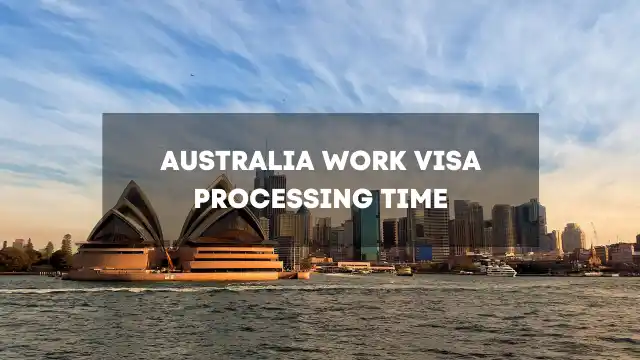Do you plan you want to live in Australia? No matter if you’re seeking employment or a temporary visa, Australia work visa processing Time? Knowing what duration of the process will help you plan your time better. Australia provides a range of types of work visas, with each having its individual wait time. In this post, you’ll find detailed information on actual processing time as well as the factors that affect it and how you can get ahead of the curve.
Table of Contents
What is the Australia Work Visa Processing Time?
The duration of processing for Australia work visas varies from 2 weeks to eight months according to the type of visa, the document’s completeness, and the volume of applications.
Read More:- How to Apply for Work Visa in Australia from India
Table: Australia Work Visa Processing Times (2025)
| Visa Type | Processing Time (75 percent of the applications) | Processing Time (90 percent of the applications) |
|---|---|---|
| Subclass 482 – Temporary Skill Shortage (TSS) | 6 weeks | 8 weeks |
| Subclass 186 – Employer Nomination Scheme | 5 months | 8 months |
| Subclass 494 – Skilled Employer Sponsored Regional | 4 months | 6 months |
| Subclass 400 – Temporary Work (Short Stay) | 10 days | 25 days |
| Subclass 407 – Training Visa | 3 months | 5 months |
| Subclass 491 – Skilled Work Regional (Provisional) | 7 months | 10 months |
NOTE: These are estimates from the Australian Department of Home Affairs and are subject to change.
What Affects the Australia Work Visa Processing Time?
Processing times are contingent on the type of visa you are applying for, completeness, health screenings, background checks and the amount of demand. Making sure that all documents are submitted correctly will drastically reduce wait time.
Top Factors That Affect Processing Time
- Visa Classification Visa categories are categorised according to different levels of complexity.
- Document Completeness: Missing information causes delays.
- Health and Character Checks. Additional checks can prolong the time.
- Applicable Volume Demand periods that are high (e.g. the year-end) result in backlogs.
- Nomination by the employer, Speedier for priority or sponsored jobs.
How to Check Your Australia Work Visa Processing Time
You can view the latest processing times at the Australian Department of Home Affairs website according to your particular visa subclass.
Step-by-Step: How to Apply for an Australia Work Visa
- Select the right visa. Choose the appropriate job visa (e.g. TSS, the 186).
- Verify the eligibility. Read the requirements on the official website.
- Be nominated for sponsored visas, and request a nomination from your employer.
- Collect documents include identification, job offer or other certifications.
- Apply online via ImmiAccount.
- Visa fee to submit your application.
- Wait for the decision. Processing time begins after submission.
Tips to Speed Up Your Visa Processing
- Submit the correct and complete documentation.
- Beware of mistakes on the online form. Be sure to avoid errors online.
- Make sure you get medical exams and check-ups with the police earlier.
- Utilise a licensed migration agent if you’re not sure.
- Respond to inquiries from immigration quickly.
Subclass Breakdown: Key Visa Types and Their Details
1. Subclass 482 – Temporary Skill Shortage (TSS) Visa
TSS visas allow skilled workers to fill the labour gap in Australia. The typical processing time is between 6 and 8 weeks for full applications.
Requirements:
- Job offer from a reputable employer.
- The qualifications and skills are in line.
- Character checks and health.
2. Subclass 186 – Employer Nomination Scheme
Subclass 186 is a permanent work visa for skilled professionals who are nominated by employers. The processing duration is approximately 5-8 months.
Requirements:
- Nominations for employers.
- Assessment of skills.
- Minimum of 3 years working experience.
3. Subclass 494 – Skilled Employer Sponsored Regional (Provisional) Visa
This visa is intended for skilled workers working in regional Australia. The processing time is typically about 4-6 months.
Requirements:
- Nominations for employers.
- Job listed on relevant lists.
- Regional region.
4. Subclass 400 – Temporary Work (Short Stay Specialist) Visa
It is used to perform temporary specialist work. The visa process is quickly-up to 10 to 25 days.
Ideal for:
- The work is short-term and highly specialised.
- Assignments with no ongoing commitments (max six months).
What to Do If Your Visa is Delayed
If you believe your work visa has been delayed, look to see if there are any missing documentation or immigration requests within your ImmiAccount. Contact the Department of Home Affairs or your visa agent.
How Long Should You Wait Before Following Up?
It is recommended to be patient until 90 percent or more of the processing estimate is over before requesting an issue with immigration officials.
Conclusion
Knowing the time required for processing Australia Work visas will save you from unexpected surprises. Make sure you select the right visa subclass, provide the correct documents and track your application through ImmiAccount. If you are prepared, you can improve your chances of speedier approval and begin working in Australia earlier.
Keep up-to-date on the most recent processing timetables via the Department of Home Affairs website.
FAQs: Australia Work Visa Processing Time
Can I work in Australia while waiting for my visa?
No, you must wait for the visa to be approved unless you’re already in Australia with a valid bridging visa.
What if I made a mistake in my application?
You can usually update or withdraw your application via ImmiAccount. Serious errors may require re-application.
Does using a migration agent speed up the process?
Not directly. But agents can help you submit a complete and error-free application, which may reduce delays.
Are visa processing times faster inside Australia?
Not necessarily. Whether you’re applying onshore or offshore, the type of visa and application accuracy matter more.
Can I track my visa application?
Yes, through your ImmiAccount. You’ll see status updates and any requests for further documents.


